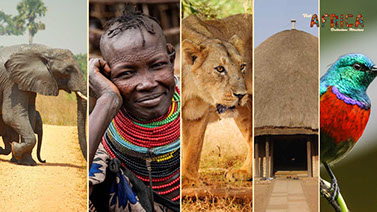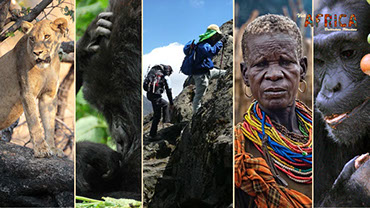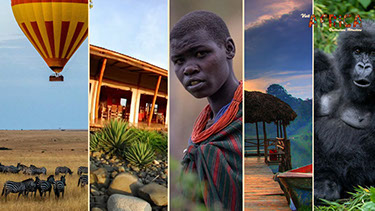Kudu
Scientific Name:
Greater kudu (Tragelaphus strepsiceros), Lesser kudu (Tragelaphus imberbis)
Weight:
Greater kudu: 120 to 315 kilograms. Lesser kudu: 60 to 105 kilograms
Size:
Greater kudu: 100 to 150 centimeters at the shoulder. Lesser kudu: 90 to 105 centimeters at the shoulder
Life span:
Up to 10 years in the wild; up to 23 years in captivity
Diet:
Herbivorous
What is a Kudu?
The two species of the Kudus look quite similar, though Greaters are larger than their lesser counterparts. The largest adult male Greaters stand over 5 ft. tall, and the largest male Lessers stand about 4 ft. tall. Greater bulls also weigh several hundred pounds more than Lessers.
Both species have long horns, which point upward and slightly back, and curl in a corkscrew shape. Their coats are reddish brown, with thin white stripes down their flanks, but the number of stripes varies based on the species.
The greater kudu is a woodland antelope found throughout eastern and southern Africa. Despite occupying such widespread territory, they are sparsely populated in most areas due to declining habitat, deforestation, and poaching. The greater kudu is one of two species commonly known as kudu, the other being the lesser kudu.
Greater kudus have a narrow body with long legs, and their coats can range from brown/bluish grey to reddish brown. They possess between 4 and 12 vertical white stripes along their torso. The head tends to be darker in colour than the rest of the body, and exhibits a small white chevron which runs between the eyes. Greater kudu bulls tend to be much larger than the cows, and vocalize much more, utilizing low grunts, clucks, humming, and gasping.
The bulls also have beards running along their throats, and large horns with two and a half twists, which, were they to be straightened, would reach an average length of 120 cm (47 in), with the record being 187.64 cm (73.87 in). They diverge slightly as they slant back from the head. The horns do not begin to grow until the bull is between the ages of 6–12 months. The horns form the first spiral rotation at around 2 years of age, and not reaching the full two and a half rotations until they are 6 years old; occasionally they may even have 3 full turns.
Predators of the greater kudu generally consist of Lions, Spotted Hyenas, and African hunting dogs. Although cheetahs and leopards also prey on greater kudus, they are unable to bring down a bull, and consequently target the more vulnerable cows and offspring. There are several instances reported where Nile crocodiles have preyed on greater kudus, although based on records the larger mammalian carnivores statistically are much more dangerous to the kudu and comparable large ungulates, or at least those with a preference for dry, upland habitats over riparian or swamp areas.
.jpg?crc=53939347)
Where do Kudu Live?
Greater Kudu and Lesser Kudu have different distribution patterns. Lesser Kudus live across a small range in eastern Africa, primarily in Kenya, Somalia, Uganda and Ethiopia. Greater Kudus have a wider range, but different subspecies live in different regions. Their populations run from the border of South Africa to Angola, Zambia, Tanzania, Kenya, and Ethiopia. A small population of Greaters also lives in small parts of Chad, Sudan, and South Sudan.
.jpg?crc=3919655420)
What are the Behaviours of Kudu?
These large mammals vary slightly in their activity. Some are more active at dusk and dawn, or at night, while others forage and socialize during the day. Herds are smaller than some other African antelopes, and Lesser Kudu frequently live in pairs. Females, their calves, and their sub adult offspring live in small herds together. Once males reach sexual maturity, they join bachelor groups of other males. As the breeding season approaches, the bachelor groups break up and the males seek out herds of females.
Greater kudus have a lifespan of 7 to 8 years in the wild, and up to 23 years in captivity. They may be active throughout the 24-hour day. Herds disperse during the rainy season when food is plentiful. During the dry season, there are only a few concentrated areas of food so the herds will congregate. Greater kudu are not territorial; they have home areas instead. Maternal herds have home ranges of approximately 4 square kilometers and these home ranges can overlap with other maternal herds. Home ranges of adult males are about 11 square kilometers and generally encompass the ranges of two or three female groups. Females usually form small groups of 6–10 with their offspring, but sometimes they can form a herd up to 20 individuals. Male kudus may form small bachelor groups, but they are more commonly found as solitary and widely dispersed individuals. Solitary males will join the group of females and calves (usually 6–10 individuals per group) only during the mating season (April–May in South Africa).
The male kudus are not always physically aggressive with each other, but sparring can sometimes occur between males, especially when both are of similar size and stature. The male kudus exhibit this sparring behaviour by interlocking horns and shoving one another. Dominance is established until one male exhibits the lateral display. In rare circumstances, sparring can result in both males being unable to free themselves from the other's horns, which can then result in the death of both animals. Rarely will a herd reach a size of forty individuals, partly because of the selective nature of their diet which would make foraging for food difficult in large groups.
.jpg?crc=4229729590)
What do Kudu eat?
Kudus are browsers and eat leaves and shoots. In dry seasons they eat wild watermelons and other fruit for their liquid content and the natural sugars that they provide. The lesser kudu is less dependent on water sources than the greater kudu. Their diet consists of leaves, grass, shoots and occasionally tubers, roots and fruit (they are especially fond of oranges and tangerines).
These large animals are herbivores, which means they primarily eat plants. They are grazers, and feed on a variety of leaves, stems, buds, flowers, fruits, and more. Most of their diet comes from trees, but they also eat shrubs and small bushes. They eat fruit that has fallen off the tree, and pluck fruits right off the branch. Most of their foraging occurs in the early morning and late afternoon.
10 Interesting Facts about Kudu
- Kudu are highly alert and notoriously hard to approach. When they detect danger – often using their large, radar-like ears – they give a hoarse alarm bark, then flee with a distinctive, rocking-horse running motion, the male laying back his horns to avoid overhead obstructions
- Kudu is easily recognized by its long, spiral horns. They can reach 72 inches in length, making 2 ½ twists.
- Characteristic colouration of their body provides protection against the predators. When kudu sense a danger, it becomes motionless. Its body colour blends with the environment and predators cannot recognize it easily.
- Kudu can survive long period without water. Part of the moisture can be compensated by the food rich in water, such as wild melon.
- Kudu is one of the loudest antelopes. It produces gruff like barking sound which is used for communication.
- Male kudus usually live solitary life or rarely form bachelor groups that travel together. Dominance in the group is established via fight. It may end up fatally for both participants if their horns lock together, preventing kudus to separate from each other. Dominance can be displayed by positioning the body sideways (body looks bigger) in front of the other males.
- Females live in the small groups composed of adult females and their offspring. Groups usually have between six and ten members.
- Mating season starts at the end of the rainy season. Pregnancy lasts eight months and ends with a single baby. Female leaves the group and isolate herself and the baby for the next couple of months.
- First four or five weeks of the life, young kudu spends lying in the grass. After that, calf starts to follow its mother during short period of time each day. At the age of three to four months, young kudu follows its mother all the time. When calf becomes able to follow its mother constantly, they will return back to the herd.
- Young kudus grow rapidly and they are able to take care of themselves as soon as they turn six months.
Architect Tourism SMC Ltd is an African tourism company, crafted to inspire and enable a breathtaking beautiful experience of Africa. Visit Africa is one of Architect Tourism SMC tourism brands. Visit Africa is inspired to craft innovative, fun and breathtaking tourism events, trips, excursions, getaways, safari, vacations, holiday, and tours experiences.
Vision: To inspire, craft, and enable a breathtaking beautiful experience of Africa.
Our Values: African, Oneness, Integrity, Client focused, Conservation focused, Innovative, Excellence, Simplicity.
Company Registration Number: 80020002986484 | Company Tax ID: 1018106912

Visit Africa is an African tourism brand, that profiles every tourist destination, in every country, in Africa; Destinations, How to get there, Attractions, Things to do, How to get around, itinerary pricing and Where to stay, for an adventurous breathtaking and thrilling experience of tourism of Africa.
Visit Africa
Destinations
Visit Namibia
We are Social!
Search this website!
Africa
Visit Africa
Visit Uganda
Visit Tanzania
Visit Zimbabwe
Visit South Africa
Visit Kenya
Visit Morocco
Tour Itineraries











Visit Africa Copyright © 2019 - Visit Africa is a Tourism Brand of Architect Tourism SMC Limited.
Wildlife in Africa
Visit Egypt

Visit Rwanda
Visit Africa's Tourism Events

Uganda Wildlife, Nature, City life & Cultural Tourism Event Experience
8 days | 3 Major Destinations | 6-25 Travellers
From $1,800





